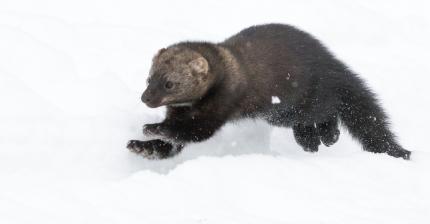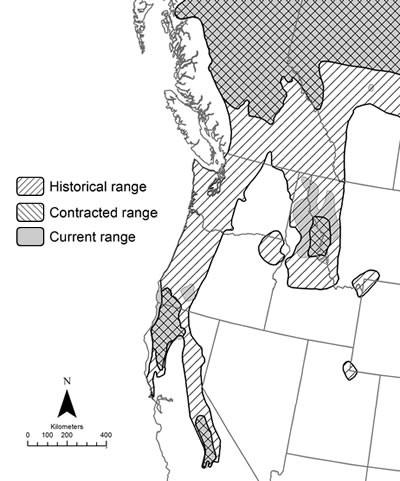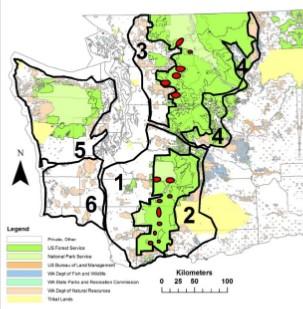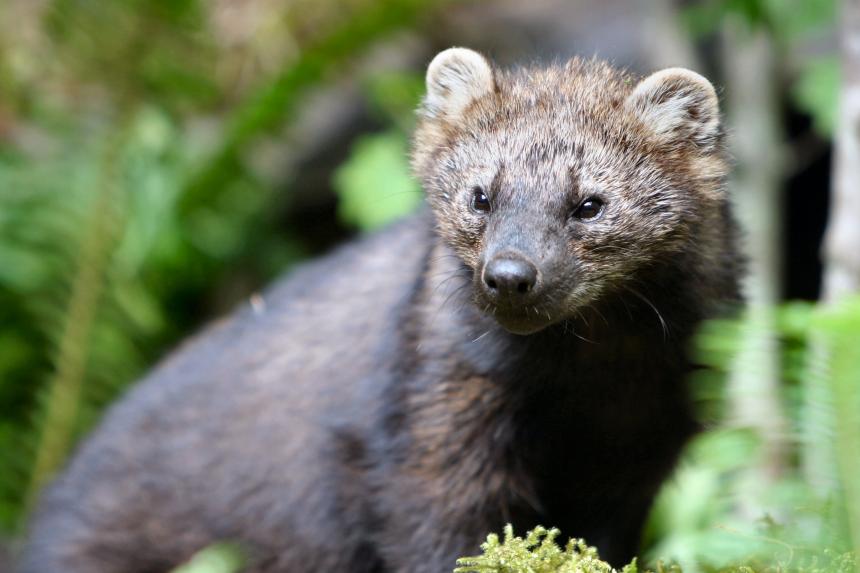Fishers, a member of the mustelid or weasel family similar in size to a housecat, are native to Washington forest habitats including the Olympic Peninsula and southwest Washington, Cascade Mountains, and northeast Washington.
Historical over-trapping, incidental mortality, and habitat loss and fragmentation caused the extirpation of fishers in Washington by the mid-1900s.
Extensive carnivore surveys conducted throughout much of the fisher's historical range in the 1990s failed to detect the species, and the fisher was listed as endangered in Washington in 1998.
Beginning in the early 2000's, WDFW and partners including the National Park Service and Conservation Northwest began undertaking feasibility studies to determine how to reintroduce fishers to Washington to restore this native species, recover biodiversity, and support natural ecosystems. Fishers eat rodents and other small mammals and are a natural component of Pacific Northwest forest ecosystems.
Fisher recovery efforts in Washington began with a fisher reintroduction project on the Olympic Peninsula from 2008 to 2012. Reintroduction projects in the Cascade Mountain Range began in 2015 and were completed in 2020.
Fisher population monitoring is ongoing in the Cascades and on the Olympic Peninsula, including distribution and occupancy studies of these areas as an index of fisher population stability and extent.
In Washington, the fisher is listed as a state endangered species and there is no trapping season for this species.
Description and Range
Physical description
The fisher is a mid-sized carnivore (4.4 to 13 pounds) in the mustelid (weasel) family that use forested habitats. Adults are about 3 to 3.5 feet in length. Males are larger than females.
The fisher is related to the mink, otter, and marten. Fishers have dark brown fur with lighter shading on the head, back of the neck, and back. They have a long furry tail (14 to 15 inches long), short rounded ears, and short legs. They have a low to the ground appearance.
A fisher may be confused with a Pacific marten which is smaller (between 1.5 to 2.5 feet in length), lighter in color, and have a much shorter tail (6.5 to 7.5 inches). These two species can occupy some of the same areas on the Olympic Peninsula and Cascade Mountain Range.
Ecology and life history
Fishers inhabit coniferous and mixed coniferous-deciduous forests. They tend to avoid areas without substantial tree cover (e.g., clear cuts, grasslands, agricultural fields), areas with significant human activity, and developed areas. Home ranges are commonly characterized by a mosaic of forest stand ages in low to mid-elevation forest landscapes, and these mosaics tend to be dominated by forests with mid-sized to large diameter trees. Fishers are consistently associated with forests that provide moderate to high canopy closure and the presence of large woody structures such as cavity trees, snags, and logs. Large trees, large snags, and large logs with cavities are important habitat features and are commonly used as rest sites and den sites.

Fishers commonly prey upon small and mid-sized mammals, such as snowshoe hares, squirrels, mice, and voles. They also feed on ungulate carrion, fruit, insects, and birds. Fishers are known for their ability to prey upon porcupines.
Females give birth when they are two years of age or older, and litter sizes range from 1 to 4 kits.
Fishers use uncharacteristically large home ranges for an animal of their size (average sizes are more than 19 square miles in northern portions of its range), with male home ranges typically being twice as large as those of females.
Vehicle collisions, and predation by bobcats, coyotes, and cougars are common sources of mortality. Bobcats are likely the most common predator of fishers in Washington; however, mountain lions, coyotes, lynx, dogs, and wolves may also prey on fishers.
Geographic range

Fishers occur only in the boreal and temperate forests of North America. They once occurred throughout the forested areas of western and northeastern Washington, and may have also occupied southeastern Washington; however, they were eliminated from the state by the mid-1900s, mainly as a result of over-trapping.
In total, 279 fishers from British Columbia and Alberta were reintroduced to forests across the Washington Cascades and Olympic Peninsula from 2008 through 2021 by WDFW, the National Park Service, Conservation Northwest and The Calgary Zoo with support from other agencies, tribes and partners.
See the Conservation section for more details.
For maps of range-wide distribution and conservation status of this species, check out NatureServe Explorer and the International Union for Conservation of Nature Red List.
Climate vulnerability
Sensitivity to climate change
Low-
Moderate
Fishers typically inhabit low to mid-elevation forests with moderate to high canopy coverage and large woody structures. Much is unknown about the species' response to climate change in Washington, but in general somewhat warmer and drier conditions could possibly benefit the species. Fishers are sensitive to deep soft snow conditions, thus reductions in snowpack and wetter snow conditions could enhance winter movements, predatory success, and competitive interactions with martens. However, warmer, drier conditions that result in larger and more intense wildfires would be harmful. Although some natural disturbances (e.g., fire, insects, disease, wind) help create important habitat structures (e.g., snags, downed logs, den sites) for fishers, increased disturbances beyond the natural range of variability may bring negative impacts. For example, forest insect and disease outbreaks that greatly reduce forest canopy coverage could lower habitat availability.
Exposure to climate change
Moderate
- Reduced snowpack
- Altered fire regimes
- Increased insect and disease outbreaks
- Increased temperatures
- Changes in precipitation
Regulations
Rules and seasons
The fisher is among the species listed as endangered in Washington. There currently is no trapping season for the fisher in the state.
Conservation
Conservation Threats and Actions Needed
- Overharvesting of biological resources
- Threat: Incidental trapping capture, highway mortality, and other mortality sources pose a risk for the reintroduced population on the Olympic Peninsula and the Cascades.
- Action Needed: Continue to monitor these populations to determine reintroduction success.
- Management decision needs
- Threat: Historical extirpation/absence of fishers in the Cascades Recovery Area, which makes up a major portion of the fisher’s historical range in Washington.
- Action Needed: Work with officials in British Columbia to procure fishers and conduct reintroductions in the southern and northern Cascades.
Our Conservation Efforts
Surveys, Reintroductions and Recovery
Extensive carnivore surveys conducted throughout much of the fisher's historical range in the 1990s failed to detect the species, and the fisher was listed as endangered in Washington in 1998.
Beginning in the early 2000's, WDFW and partners including the National Park Service and Conservation Northwest began undertaking feasibility studies to determine how to reintroduce fishers to Washington to restore this native species, recover biodiversity, and support ecosystem resilience. Fishers eat rodents and other small mammals and are a natural component of Pacific Northwest forest ecosystems.
In total, 279 fishers from British Columbia and Alberta were reintroduced to forests across the Washington Cascades and Olympic Peninsula from 2008 through 2021 by WDFW, the National Park Service, Conservation Northwest and The Calgary Zoo with support from other agencies, tribes and partners.
This includes 170 fishers introduced to Washington's North and South Cascade Mountains from British Columbia and Alberta through the Cascades Fisher Reintroduction Project from 2014 through 2020. The Olympic Fisher Reintroduction Project ran from 2008 to 2012, and included an initial 90 fishers reintroduced from British Columbia.
After the overall reintroduction project goals were met in 2020, 19 additional fishers were released at sites around Olympic National Park and Olympic National Forest in November and December of 2021 to boost the numbers and genetic diversity of fishers on the Olympic Peninsula using animals live-trapped in Alberta.
Reintroductions have been successful at reestablishing fisher populations throughout much of the southern portion of their North American range, and because of this success, fisher reintroductions to the Olympic Peninsula and the Cascade Range were a prominent component of the fisher recovery plan for Washington.
Reintroductions have been implemented in Washington because there is sufficient quality and connected mid-elevation forest habitat to support reintroduced populations. Federal, state, tribal, and private lands provide habitat for fishers in Washington and these forests are managed under a variety of approaches that can support fisher populations.
Fisher Candidate Conservation Agreement with Assurances are available for private timberlands and other landowners where fishers may be present. See below for more details.
Surveys from 2013 to 2016 indicated that reintroduced fishers were reproducing and were widely distributed on the Olympic Peninsula. While we don’t currently have specific estimates available, monitoring efforts in the southern and northern portions of the Cascade Range and on the Olympic Peninsula will be continued into the future to evaluate the long-term success of these reintroduction efforts, including distribution and occupancy studies of these areas as an index of fisher population stability and extent.
Overall, project partners feel this collaborative work was a significant step toward recovering the species in Washington.
The Washington Fisher Reintroduction Project partners were:
- WDFW
- National Park Service (Olympic National Park, Mount Rainier National Park and North Cascades National Park)
- Conservation Northwest
- The Calgary Zoo
Additional project partners and supporters include the U.S. Forest Service, British Columbia Ministry of Environment, U.S. Fish and Wildlife Service, Northwest Trek, Defenders of Wildlife, Native American Tribes, Canadian First Nations, the Alberta Trappers Association, and many others.
Cascade Reintroduction Project
- Cascades Fisher Reintroduction Project: Final Project Report 2022
- Cascades Fisher Reintroduction Project: Progress Report for March 2017 to February 2018
- Cascades Fisher Reintroduction Project: Progress Report for December 2015 to March 2017
Olympic Reintroduction Project
- Post-Release Movements, Survival, and Resource Selection of Fishers (Pekania pennanti) Translocated to the Olympic Peninsula of Washington (2014)
- Evaluation of Fisher Restoration in Olympic National Park and the Olympic Recovery Area: 2013 Annual Progress Report
- Olympic Fisher Reintroduction Project: Progress Report 2008-2011
- Olympic Fisher Reintroduction Project: 2010 Progress Report
- Olympic Fisher Reintroduction Project: 2009 Progress Report
- Olympic Fisher Reintroduction Project: 2008 Progress Report
WDFW Fisher Candidate Conservation Agreement with Assurances (CCAA)

Management of forested habitats that support fishers is guided by a number of planning efforts that include the Northwest Forest Plan (federal lands), numerous habitat conservation plans (for non-federal lands), State Forest Practice rules (for private lands), and the Candidate Conservation Agreement with Assurances (CCAAs) for fishers in Washington (for non-federal landowners).
A CCAA is a voluntary agreement whereby willing landowners agree to help promote the conservation of a species that may later become listed under the federal Endangered Species Act (ESA). In return, landowners receive assurances against additional land-use restrictions should the species covered by the CCAA ever become listed for protection under federal law.
WDFW, in coordination with U.S. Fish and Wildlife Service (USFWS), has provided incentives to landowners and the forest industry to work as partners for fisher recovery through the CCAA program.
In the spring of 2016, the USFWS took these efforts into account when it determined that the state's fisher population did not require protection under the ESA. At the time of this decision, WDFW had enrolled 25 landowners and 1.4 million acres. As of summer 2019, those numbers have increased to 58 landowners and over 3.027 million acres enrolled in the CCAA, helping significantly with fisher reintroduction and recovery efforts. In November 2019, the USFWS published a revised proposed rule for fisher which clarified that Washington was subsequently excluded from the west coast fisher distinct population segment boundaries.
See information on how voluntary agreements protect fishers and forest landowners (PDF), plus check out CCAA FAQs.
CCAA Frequently Asked Questions
What is the Fisher Candidate Conservation Agreement with Assurances (CCAA)?
- The Fisher CCAA is a conservation agreement between the Washington Department of Fish and Wildlife (WDFW) and the U.S. Fish and Wildlife Service (USFWS). It is designed to promote the conservation of fishers in Washington while also addressing landowner concerns about potential regulatory restrictions that could result from having a species on their land that could be listed for protection under the federal Endangered Species Act (ESA).
- Participating landowners agree to follow conservation measures detailed in the CCAA to protect fishers that may move onto their lands. In return, enrolled landowners will receive assurances that USFWS will not require additional conservation measures or land, water, or resource use restrictions beyond those voluntarily agreed to in the CCAA.
Who is potentially eligible to enroll in the fisher CCAA?
- Any non-federal landowner who owns forested lands near Washington's Olympic Peninsula, South Cascades or North Cascades fisher recovery zones (see map).
When can a landowner enroll in the fisher CCAA?
- The USFWS approved the CCAA in 2016 and WDFW continues enrolling landowners. Eligible landowners can enroll in the CCAA any time prior to a point at which the species becomes listed under the ESA.
- In September 2018, the Northern District Court for California overturned the 2016 USFWS decision to withdraw their proposed rule to list fishers under the ESA. The result is that the fisher is once again a candidate for listing under ESA. USFWS is required to re-evaluate the proposed listing rule and publish findings in September 2019.
Can CCAA enrollment continue if fishers are not federally listed?
- Yes, landowner enrollment in the CCAA will continue so long as the species is not listed as threatened or endangered in Washington by USFWS. The 2018 court ruling highlights the advantage to landowners of enrolling in the CCAA, and WDFW continues seeking partnerships with landowners to help with fisher conservation and recovery.
What regulatory assurances are provided to landowners enrolled in the fisher CCAA?
- Landowners choosing to enroll in the CCAA receive assurances that USFWS will not require additional conservation measures or land, water, or resource use restrictions beyond those they voluntarily agreed to under the CCAA.
What are the terms for landowners who enroll in the fisher CCAA in Washington?
- Conservation measures included under the Fisher CCAA are outlined on Page 13 of the agreement. Those enrolled in the CCAA agree to:
- Work with WDFW wildlife managers to monitor fishers and their dens in the event that a den site is found on their property;
- Avoid harming or disturbing denning females and their young by limiting or preventing access and disturbance within 0.25 miles of known dens;
- Protect denning females by prohibiting trapping and nuisance animal control activities within 2.5 miles of known occupied dens;
- Cover large water troughs/containers on enrolled lands or install devices on water retention structures to prevent fishers from becoming entrapped;
- Where landowners are interested and when supported by WDFW, allow fisher reintroductions in suitable habitat; and,
- Report den sites and sick, injured, or dead fishers on enrolled lands.
- The conservation measures go into effect as soon as the landowner signs on as a participant to the CCAA and remain in effect for the term of the agreement regardless of whether or not the species becomes federally listed.
How does this CCAA benefit fishers?
- WDFW has been engaged in a reintroduction program to reestablish fishers in their former range throughout western Washington since 2008. Landowners participating in the CCAA are key partners in these efforts as fishers reestablish themselves in the state.
- Since WDFW is actively recovering fishers through reintroductions, it is important that non-federal landowners continue to be supportive partners of these efforts. Fishers were reintroduced to the Olympic Peninsula from 2008-2010, with more recent fisher releases in the South Cascades from 2015-2018 and into the North Cascades beginning in winter 2018/2019.
- Washington's current fisher recovery efforts are aided by increased monitoring and communication opportunities with non-federal landowners that may have fishers using habitat on their lands.
- Breeding fishers are protected from disturbance and direct harm while they are raising young.
- The threat of drowning in water troughs or other water retention structures on enrolled lands is reduced by preventing entry or providing means for a fisher to escape.
- Additional fishers could be reintroduced onto CCAA-enrolled lands where participating landowners were interested and quality fisher habitat was available.
What is the term of the Fisher CCAA?
- The Fisher CCAA was issued to WDFW in mid-April 2016 and will be effective for 20 years.
- Landowners may choose to enroll in the Fisher CCAA for terms between 10 and 20 years initially. If WDFW seeks to extend the CCAA beyond the 20-year term and gains USFWS approval, landowners may voluntarily extend their participation if they choose to do so.
- WDFW will continue enrolling willing landowners so long as the fisher is not listed as threatened or endangered under the ESA. If the species becomes listed as threatened or endangered, enrollment must cease. Only those landowners that have enrolled in the CCAA prior to the date the species is listed will receive the assurances provided in the agreement.
- Although Washington fishers were not federally listed in 2016, it is unclear whether or not they will become listed under the ESA based upon the current re-evaluation by USFWS regarding whether or not they should be listed.
Can enrolled landowners leave the program before the term expires?
- Yes. Enrollment in the Fisher CCAA agreement is voluntary and participating landowners may choose to discontinue participation at any time. However, choosing to end participation in the Fisher CCAA would terminate any assurances provided under the agreement.
What if I want to sell or transfer property covered under the Fisher CCAA?
- The Fisher CCAA is tied to the participating landowner, not the property.
- Enrollees are required to notify WDFW in writing within 30 days following sale or transfer of covered lands. Upon sale of the property, the new landowner is not obligated to follow any of the Fisher CCAA conservation measures.
- If a property owner sells or gives away lands enrolled in the Fisher CCAA, the new owner can enroll the property in the CCAA if they chose to do so.
How does a landowner enroll in the Fisher CCAA?
- If a landowner has questions or would like to enroll some or all of their lands, they can contact WDFW. Currently, the designated contact for the Fisher CCAA is Gary Bell (gary.bell@dfw.wa.gov; 360-902-2412).
Resources
References
Powell, R. A., S. W. Buskirk, and W. J. Zielinski. 2003. Fisher and marten. Pp 635-649 in G. A. Feldhamer, B. C. Thompson and J. A. Chapman, editors. Wild mammals of North America: biology, management and conservation, 2nd edition. Johns Hopkins University Press, Baltimore, Maryland.
Zielinski, W. J., K. M. Slauson, C. R. Carroll, C. J. Kent, and D. G. Kudrna. 2001. Status of American martens in coastal forests of the Pacific States. Journal of Mammalogy 82:478-490.
WDFW publications
Recovery plans
- Washington State Fisher Recovery Plan (2006)
- Implementation Plan for Reintroducing Fishers to the Cascade Mountain Range in Washington (2013)
Status reports
- Periodic Status Review for the Fisher in Washington (2017)
- Washington State Status Report for the Fisher (1998)


.jpg?crop=no&k=c&w=860&h=645)